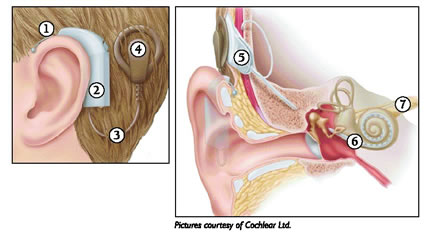The cochlear implant bypasses
the damaged parts of the inner ear and directly stimulates the remaining
hearing nerve fibers in the cochlea with electrical signals.
The cochlear implant consists of two basic components: an outer (external) and
an inner (internal) device. The external device consists
of a speech processor (see #2, figure below) (worn either as a body worn
or as a behind-the-ear device(#2)), a transmitting coil(#4), a directional
microphone(#1) and connecting cords(#3). The internal device consists of
a receiver/stimular(#5) (placed directly below the skin) and a multi-electrode
wire array(#6), which is inserted into the inner ear (cochlea). The transmitting
coil of the external device is secured over the receiver/stimulator of the
internal device through magnetic attraction.

The Cochlear Implant System works in the following
manner:
1. Sounds are picked up in the small, directional
microphone located in the ear level speech processor.
2. The speech processor filters, analyzes and
then digitizes sound into coded electrical signals.
3. The coded signals are sent from the speech
processor to the transmitting coil.
4. The transmitting coil sends the coded signals
as FM radio signals to the cochlear implant under the skin.
5. The cochlear implant delivers the appropriate
electrical signals to the electrode array, which has been inserted
into the cochlea.
6. The electrodes along the array stimulate
the auditory nerve (hearing nerve) fibers in the cochlea.
7. The resulting electrical signal is sent through
the auditory system to the brain where the signal is interpreted.
After a period of rehabilitation, these signals are interpreted in
the brain as sound.



